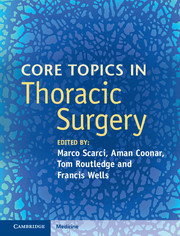Book contents
- Frontmatter
- Contents
- List of contributors
- Section I Diagnostic work-up of the thoracic surgery patient
- Section II Upper airway
- 5 Therapeutic bronchoscopy
- 6 Tracheal stenosis, masses and tracheoesophageal fistula
- Section III Benign conditions of the lung
- Section IV Malignant conditions of the lung
- Section V Diseases of the pleura
- Section VI Diseases of the chest wall and diaphragm
- Section VII Disorders of the esophagus
- Section VIII Other topics
- Index
- References
5 - Therapeutic bronchoscopy
from Section II - Upper airway
Published online by Cambridge University Press: 05 September 2016
- Frontmatter
- Contents
- List of contributors
- Section I Diagnostic work-up of the thoracic surgery patient
- Section II Upper airway
- 5 Therapeutic bronchoscopy
- 6 Tracheal stenosis, masses and tracheoesophageal fistula
- Section III Benign conditions of the lung
- Section IV Malignant conditions of the lung
- Section V Diseases of the pleura
- Section VI Diseases of the chest wall and diaphragm
- Section VII Disorders of the esophagus
- Section VIII Other topics
- Index
- References
Summary
Background introduction
The celebrated American oto-rhino-laryngologist Chevalier Jackson has been an important player in the field of bronchoscopy since the 1920s. His instrument, with a few modifications, became what is basically the rigid bronchoscope (RB) of today. By the 1950s, bronchoscopy became a well-established procedure, and every trainee thoracic surgeon had to be proficient in diagnostic and therapeutic bronchoscopy, the latter being confined to foreign body (FB) removal, clearing the tracheo-bronchial tree of secretions, cauterization of bleeding tumours and therapeutic bronchial lavage.
The flexible fibreoptic bronchoscope (FFB) was developed in the 1960s, the first instrument being designed by the Japanese, Shigeto Ikeda. Its flexibility allowed examination of segmental bronchi. Until then this had only been possible with the use of straight and right-angled telescopes introduced through the rigid bronchoscope. The ease of FFB bronchoscopy under topical anaesthesia and sedation attracted respiratory physicians, and for thoracic surgeons, the flexible instrument became an important addition to bronchoscopic instrumentation for use independently or in conjunction with the rigid instrument. At present, for the thoracic surgeon, the two instruments are complementary to one another, and skills in both are necessary for the diagnosis of endobronchial lesions and for therapeutic endoscopic interventions.
Instrumentation and general principles of therapeutic bronchoscopy
Rigid bronchoscope (RB)
RB alone, or in conjunction with the FFB, remains the instrument of choice and sine qua non of many therapeutic bronchoscopies. Accessory devices include a range of forceps for grasping, provision of biopsy and/or punching/coring out tumours, dilators and diathermy probes. In addition, operative bronchoscopes have been designed for specific interventions such as lasertherapy. Rigid bronchoscopy is performed under general anaesthetic during which ventilation is provided most effectively by hand-operated (Sander's) injectors or jet ventilation. The author's preference is the injector, since it allows effective control by the anaesthetist.
Flexible fibreoptic bronchoscope (FFB)
There are now a number of FFBs available with various accessory devices, such as biopsy forceps, needles for injection, aspirators and dilators.
FFB offers a recording system and monitor for live viewing and storing of bronchoscopic events. It can incorporate a fluorescence imaging system for auto-fluorescence bronchoscopy (AFB), which is several times more sensitive than white light in imaging pre- and early neoplastic endobronchial lesions.
- Type
- Chapter
- Information
- Core Topics in Thoracic Surgery , pp. 39 - 47Publisher: Cambridge University PressPrint publication year: 2016



